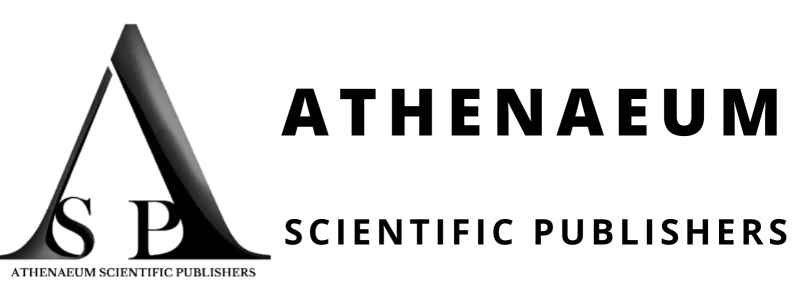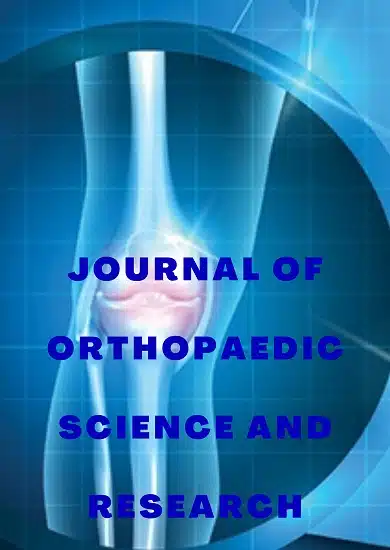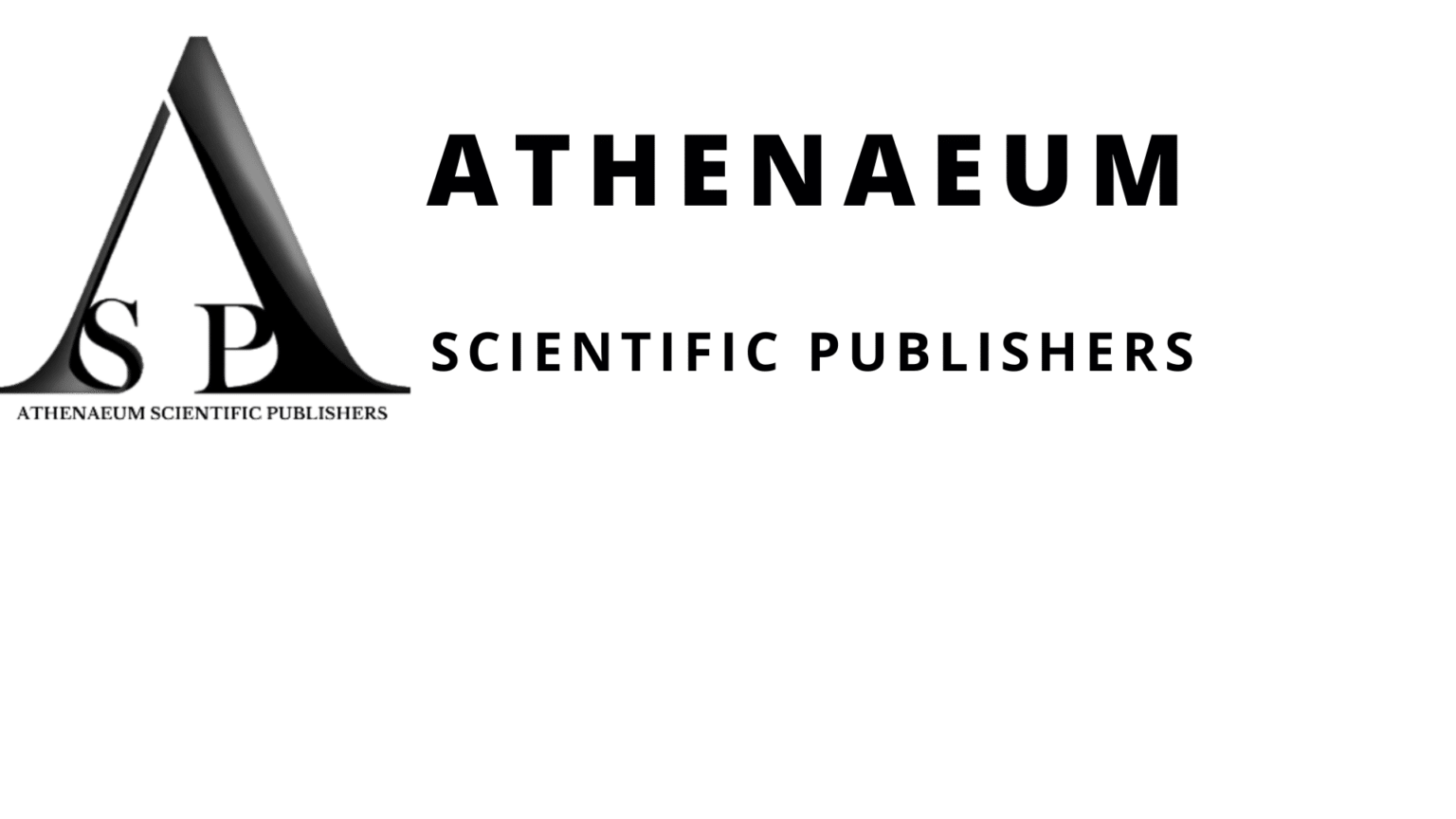Case Report | Vol. 6, Issue 1 | Journal of Orthopaedic Science and Research | Open Access |
Autologous Semitendinosus Graft Augmentation in Patellar Tendon Re-Rupture Repair: A Case Report
Alberto Mameli1*, Alessandro Sangiorgio1, Simone Verzellotti1, Marco Delcogliano2
1Service of Orthopaedics and Traumatology, Department of Surgery, EOC, Lugano, Switzerland
2Lugano Orthopaedic Group (LOG Medica), Lugano, Switzerland
*Correspondence author: Alberto Mameli, MD, Service of Orthopaedics and Traumatology, Department of Surgery, EOC, Lugano, Switzerland Via Pietro Capelli 1, CH-6962, Viganello; Email: [email protected]
Citation: Mameli A, et al. Autologous Semitendinosus Graft Augmentation in Patellar Tendon Re-Rupture Repair: A Case Report. J Ortho Sci Res. 2025;6(1):1-7.
Copyright© 2025 by Mameli A, et al. All rights reserved. This is an open access article distributed under the terms of the Creative Commons Attribution License, which permits unrestricted use, distribution, and reproduction in any medium, provided the original author and source are credited.
| Received 08 April, 2025 | Accepted 23 April, 2025 | Published 30 April, 2025 |
Abstract
Introduction: Patellar tendon ruptures can occur at every point of the tendon length, from patella’s inferior pole to the anterior tibial tubercle. Treatment of acute patellar tendon ruptures involves direct tendon-to-tendon repair or transosseous sutures, usually combined with an additional procedure to temporarily protect the repair. This article describes the use of semitendinosus graft in the treatment of a patellar tendon early re-rupture.
Case Presentation: A 69-year-old male patient suffering a complete traumatic rupture of the patellar tendon was operated with direct end-to-end tendon suture using the Kessler technique and augmentation with PDS Cord. Twenty days after surgery, he suffered a further knee injury with recurrence of tendon rupture at the same height of primary rupture.
In the second surgery, the previous suture was removed and the tendon stumps were debrided. Two sutures with Krackow technique were performed using FiberWire in both the proximal and distal stump. Semitendinosus tendon was harvested. Two transosseous tunnels were drilled at the middle third of the patella and of the anterior tibial tuberosity. The semitendinosus graft was inserted transversely through the tunnel into the tibial tuberosity. Correct patella height was reached using the contralateral patella as a reference. Then, the two tails of the graft were sutured together.
For the first 2 weeks post-operatively, the knee was immobilized in an extension brace, with a full weight bearing allowed. Subsequently, an articulated brace was placed with progressively increasing flexion angles (30° increase every 2 weeks). The patient continued physical therapy for a total of 5 months. At the last follow-up visit (24 weeks post-operatively), the patient was pain free and had returned to work. Knee range of motion was complete and comparable to the contralateral knee.
Keywords: Petellar Tendon; Tendon Rupture; Tendon Suture; Autologous Semitendinosus; Graft Augmentation
Introduction
Patellar tendon rupture is a clinical condition characterized by a partial or complete tear of the patellar tendon, which can occur at every point of its length, from patella’s inferior pole to the anterior tibial tubercle [1]. Acute patellar tendon ruptures are relatively rare, occurring usually in young male patients after trauma, with a typical mechanism of a forceful quadriceps muscle contraction with a flexed knee. On the other side, chronic ruptures are associated with progressive tendinopathies caused by repetitive micro traumas, diabetes, rheumatoid arthritis, chronic renal failure or steroid intake [2].
Complete patellar tendon rupture diagnosis can be made after clinical examination, documenting the inability to extend the leg. A palpable substance defect distally to the patella and a patella alta are other pathognomonic features of patellar tendon rupture. Even if the diagnosis is clinical, radiological examinations, which include ultrasound, X-Ray or magnetic resonance imaging, can be helpful in the diagnostic process, excluding other lesions, especially in case of a post-traumatic ruptures [3].
Treatment of acute patellar tendon ruptures involves direct tendon-to-tendon repair or transosseous sutures, usually combined with an additional procedure to temporarily protect the repair [4,5]. This article describes the use of semitendinosus graft in the treatment of a patellar tendon early re-rupture.
Case Presentation
This article describes the case of a 69-year-old patient, known for ischaemic heart disease undergoing antiplatelet therapy, who first presented to the emergency department on June 24th 2024 after an accidental fall onto a sheet of glass, causing a transverse cut below the right patella and an anterior-inferior dislocation of the right shoulder, which was reduced under sedation.
The cut at the level of the right knee measured approximately 8 cm and was about half the length of the patellar tendon (Fig. 1). At the exploration of the wound, a complete transverse rupture of the patellar tendon was already appreciated. The X-ray showed no fractures, but showed a Caton Deschamps index of 1.75 (Fig. 2).
The patient was initially operated with direct end-to-end tendon suture with Fiberwire using the Kessler technique and debridement of the skin wound. In addition to the suture, an augmentation with PDS Cord through tibial and patellar tunnels was performed in order to reduce tension on the tendon suture (McLaughlin technique) (Fig. 3) [6].
Twenty days after surgery, the patient suffered a further knee injury with recurrence of skin and tendon injury at the same height as the primary rupture. There was a visible patella alta and the extensor mechanism was clinically disrupted. The patient was not able to lift up the right leg and he was unable to extend his knee from a flexed position. There were no vascular or sensitive deficits (Fig. 4).
The abovementioned findings on physical examination were confirmed with X-ray, showing a recurrent patellar tendon rupture with patella alta (Caton Deschamps index 1.76) (Fig. 5). Revision surgery was indicated. Risks of surgery and anesthesia were explained to the patient who agreed with the plan and signed informed consent.
Surgical Technique
The patient was placed under spinal anesthesia and intravenous antibiotic prophylaxis was administered. He was positioned on the operating table in supine position with a support under the popliteal fossa to keep the knee in 30° flexion. The procedure started with a range of motion and a radiological check of the contralateral knee which showed a Caton Deschamps index of 1. No tourniquet was placed. The knee was prepped and draped in the usual sterile fashion. The transverse wound that the patient presented was extended both distally in the medial region and proximally in the lateral region of the knee.
Surgical Technique
The patient was placed under spinal anesthesia and intravenous antibiotic prophylaxis was administered. He was positioned on the operating table in supine position with a support under the popliteal fossa to keep the knee in 30° flexion. The procedure started with a range of motion and a radiological check of the contralateral knee which showed a Caton Deschamps index of 1. No tourniquet was placed. The knee was prepped and draped in the usual sterile fashion. The transverse wound that the patient presented was extended both distally in the medial region and proximally in the lateral region of the knee.
Subsequently, the patellar tendon was examined and it appeared completely ruptured at the same level as the previous injury, in the middle of its length. The previous suture was removed and the proximal and distal tendon stumps were debrided. There was also a recurrent rupture of the medial and lateral retinacula. Two sutures with Krackow technique were performed using FiberWire in both the proximal and distal stump. The sutures were knotted, with good tendon length restoration. The medial and lateral retinacula were also sutured with Vicryl 2.0.
After finishing the end-to-end suture of the patellar tendon, two transosseous tunnels were drilled at the level of the middle third of the patella and of the anterior tibial tuberosity. Care was taken not to damage the articular surface of the patella in order to prevent future patello-femoral osteoarthritis. The inner diameter of the tunnels was equal to the diameter of the tendon, 6 mm. The semitendinosus graft was placed in the proximal tunnel and inserted transversely through the tunnel into the tibial tuberosity. The patella was mobilized in its anatomical position moving the knee across its range of motion from 0° to 90° and using the contralateral patella as a reference. Once the correct patella height was reached, the two tails of the semitendinosus graft were paired and sutured together (Fig. 6). There was no need for a quadriceps release. After finishing, the executed suture appeared stable with the knee in 90° flexion (Fig. 7).
Extensive irrigation was performed, followed by hemostasis. Closure was done using 2.0 Vicryl for deep dermis and 3.0 nylon for the skin. Sterile dressing was applied followed by a knee immobilizer. The patient well tolerated the entire procedure.
Post-Operative Rehabilitation and Follow-Up
The patient had a non-eventful recovery after surgery. He was hospitalized for five days to control post-operative pain and the surgical scar. For the first 2 weeks, the knee was immobilized in an extension brace, with a full weight bearing allowed. Subsequently, an articulated brace was placed with progressively increasing flexion angles (30° increase every 2 weeks). The stitches were removed 15 days after surgery and the wound did not present any complications or dehiscence. At 6 post-operative weeks, knee range of motion was 0-60° and X-ray showed stable patellar repair. The patient was fully weight bearing with crutches. At 12 weeks post-operatively, the patient had no knee pain and reached 130° of flexion. He was no longer using crutches. He continued physical therapy for a total of 5 months. Last follow-up visit was post-operatively for 24 weeks post-operatively. The patient had completed physical therapy and had successfully returned to work. Knee range of motion was complete and comparable to the contralateral knee. The X-ray showed a correct patella height with Caton Deschamps index at 1 (Fig. 8).
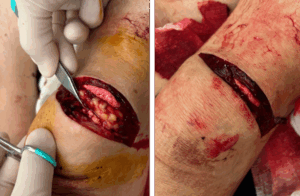
Figure 1: Clinical presentation of the right knee at admission following the first injury on June 24th 2024. A complete transverse rupture of the patellar tendon can be appreciated.
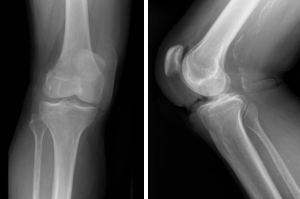
Figure 2: X-rays of the right knee at admission following the first injury on June 24th 2024. A Caton Deschamps index of 1.75 was measured.
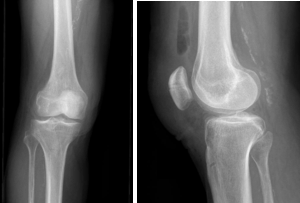
Figure 3: Right knee X-rays after the first surgery. 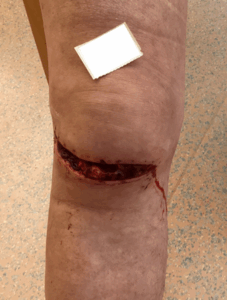
Figure 4: Clinical presentation of the right knee following the second injury. Skin suture from the previous surgery appeared completely open.
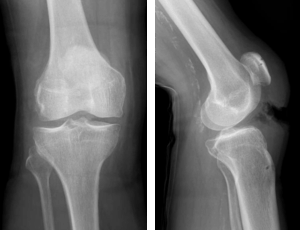
Figure 5: Right knee X-ray at admission after the second injury. A Caton Deschamps index of 1.76 was measured.
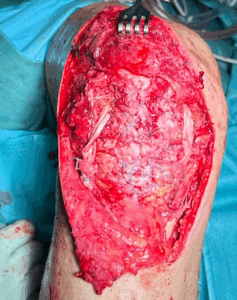
Figure 6: Intraoperative picture of the revision surgery on the right knee after patellar tendon re-suture.
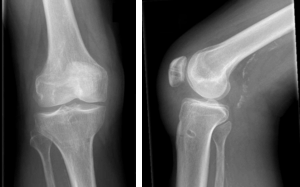
Figure 7: X-ray of the surgical site (right knee) following the revision surgery.
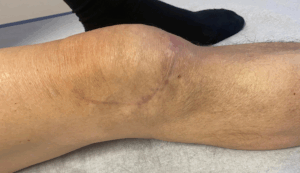
Figure 8: Clinical appearance of the surgical site (right knee) following the revision surgery.
Discussion
Patellar tendon rupture following a previous tendon repair may represent a devastating injury, with revision surgeries being very challenging. Re-rupture is a very uncommon condition and provides the orthopaedic surgeon with a difficult problem. Large trials have never been performed and therefore there are no gold standard protocols for surgical treatment or rehabilitation programs. This article showed a promising and successful technique for patellar tendon reconstruction after re-rupture with end-to-end suture and augmentation/reinforcement with semitendinosus tendon autograft. We advocate for autograft reconstruction as a method of tendon augmentation, including the passage and incorporation through bone tunnels. Allograft reconstruction has an increased risk of infection and weakness secondary to radiation of the tendon graft. The best treatment method for patellar tendon rupture recurrences is controversial; however, we believe that the technique described above results in a robust structure that allows for the return of knee strength and function through early rehabilitation. Given the rarity of this type of injury, there is a paucity of comparative literature to guide management. Future long-term studies are needed to evaluate the long-term results of this injury and to validate the surgical technique. Previous cases of reconstruction with autograft of the ipsilateral semitendinosus have shown positive results and a relatively quick return to physical activity with rehabilitation [3,7-10].
Conclusion
This article described a modified surgical technique for patellar tendon revision surgery, involving a reinforcing cerclage with semitendinosus tendon passed through 2 bony tunnels, providing a stronger structure, as well as assuring an excellent range of motion and a return to previous activity levels after 6-months of follow-up.
Conflict of Interests
The author declares no conflict of interest.
Authorship Contribution Statement
Alberto Mameli: Conceptualization, surgery, follow-ups, original draft, manuscript revision
Alessandro Sangiorgio: Conceptualization, original draft
Marco Delcogliano: Surgery, follow-ups, manuscript revision
Simone Verzellotti: Surgery, follow-ups, manuscript revision
Funding/Sponsorship
Not applicable
References
- Hsu H, Siwiec RM. Patellar tendon rupture. StatPearls. Treasure Island (FL). 2025.
- Amlang MH, Zwipp H. Damage to large tendons: Achilles, patellar and quadriceps tendons. Der Chirurg; Zeitschrift fur Alle Gebiete der Operativen Medizen. 2006;77(7):637-49.
- McRae S, Leiter J, McCormack R, Old J, MacDonald P. Ipsilateral versus contralateral hamstring grafts in anterior cruciate ligament reconstruction: a prospective randomized trial. The Am J Sports Medicine. 2013;41(11):2492-9.
- Dejour H, Denjean S, Neyret P. Treatment of old or recurrent ruptures of the patellar ligament by contralateral autograft. Rev Chir Orthop Reparatrice Appar Mot. 1992;78(1):58-62.
- Thorne TJ, Dong W, Higgins TF, Rothberg DL, Haller JM, Marchand LS. Primary repair of complete quadriceps tendon rupture with extensor mechanism deficit. JBJS Essential Surgical Techniques. 2024;14(3):e23.
- Ahrberg A, Josten C. Augmentation of patella fractures and patella tendon ruptures with the McLaughlin-Cerclage. Der Unfallchirurg. 2007;110:685-90.
- Abdou YE. Reconstruction of a chronic patellar tendon rupture with semitendinosus autograft. Arch Orthop Trauma Surg. 2014;134(12):1717-21.
- Espregueira-Mendes J, Andrade R, Michael MF, Sarmento A, Sevivas N, Rocha R, et al. Augmentation of patellar tendon repair with autologous semitendinosus graft-Porto technique. Arthrosc Tech. 2017;6(6):e2271-6.
- Haskoor JP, Busconi BD. Patellar tendon reconstruction using semitendinosus autograft with preserved distal insertion for treatment of patellar tendon rupture after bone–patellar tendon–bone ACL reconstruction: A case report. Orthopaedic Journal of Sports Medicine. 2019;7(10):2325967119877802.
- Nguene-Nyemb AG, Huten D, Ropars M. Chronic patellar tendon rupture reconstruction with a semitendinosus autograft. Orthopaedics and Traumatology: Surgery and Research. 2011;97(4):447-50.
Author Info
Alberto Mameli1*, Alessandro Sangiorgio1, Simone Verzellotti1, Marco Delcogliano2
1Service of Orthopaedics and Traumatology, Department of Surgery, EOC, Lugano, Switzerland
2Lugano Orthopaedic Group (LOG Medica), Lugano, Switzerland
*Correspondence author: Alberto Mameli, MD, Service of Orthopaedics and Traumatology, Department of Surgery, EOC, Lugano, Switzerland Via Pietro Capelli 1, CH-6962, Viganello; Email: [email protected]
Copyright
Alberto Mameli1*, Alessandro Sangiorgio1, Simone Verzellotti1, Marco Delcogliano2
1Service of Orthopaedics and Traumatology, Department of Surgery, EOC, Lugano, Switzerland
2Lugano Orthopaedic Group (LOG Medica), Lugano, Switzerland
*Correspondence author: Alberto Mameli, MD, Service of Orthopaedics and Traumatology, Department of Surgery, EOC, Lugano, Switzerland Via Pietro Capelli 1, CH-6962, Viganello; Email: [email protected]
Copyright© 2025 by Mameli A, et al. All rights reserved. This is an open access article distributed under the terms of the Creative Commons Attribution License, which permits unrestricted use, distribution, and reproduction in any medium, provided the original author and source are credited.
Citation
Citation: Mameli A, et al. Autologous Semitendinosus Graft Augmentation in Patellar Tendon Re-Rupture Repair: A Case Report. J Ortho Sci Res. 2025;6(1):1-7.
